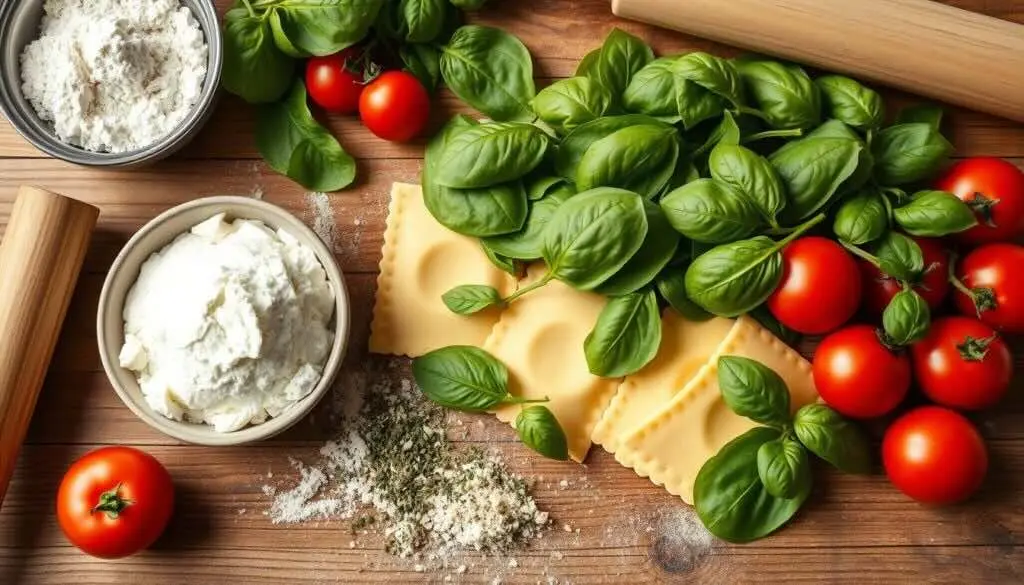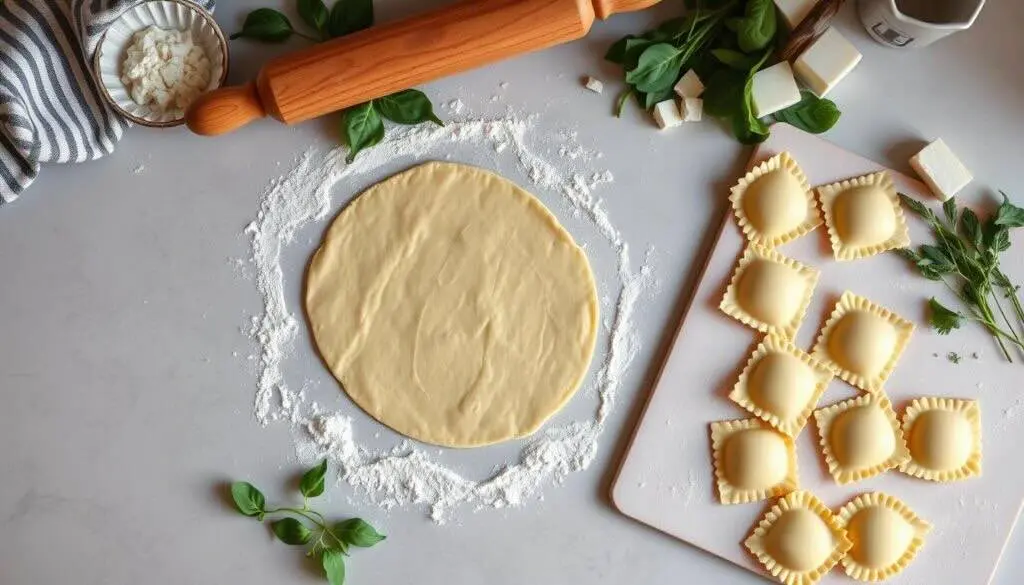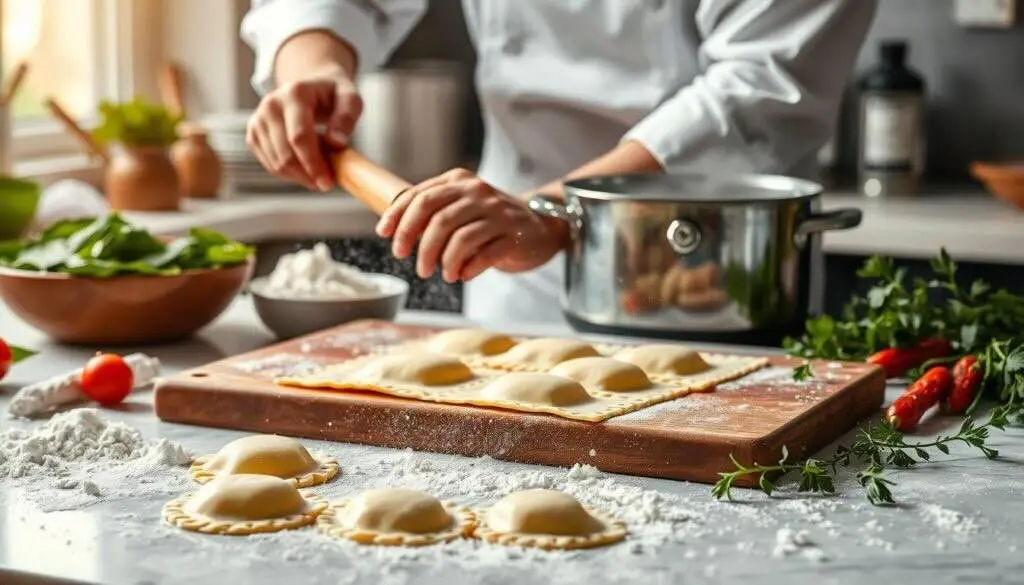Ever thought about making restaurant-quality gluten free ravioli at home? It might seem hard, but you can do it in just 25 minutes. With the right techniques, your dinner will go from ordinary to amazing.
Making gluten free ravioli is a fun challenge. It’s a great way to try new recipes if you have dietary restrictions. These four tips will make you a pro at making homemade gluten free ravioli.
Start your journey to making perfect gluten free ravioli. Use the right measurements, choose the best ingredients, and prepare smartly. You’ll make pasta that’s as good as what you find in restaurants.
Table of Contents
Key Takeaways
- Master gluten free ravioli preparation in under 25 minutes
- Learn essential techniques for creating tender, delicious pasta
- Understand the importance of proper flour blends and ingredient ratios
- Discover professional tips for preventing common gluten-free cooking challenges
- Transform your home cooking with restaurant-quality gluten free ravioli
Understanding Gluten Free Ravioli Basics

Making gluten free ravioli is all about knowing the right ingredients and techniques. With more people dealing with celiac disease or gluten sensitivities, it’s a fun challenge for everyone. Whether you’re a home cook or a pro chef, it’s a great skill to learn.
Essential Ingredients for Perfect Pasta Dough
The ingredients you choose are key to making great gluten free ravioli. A good pasta dough needs:
- Gluten free flour blend (like rice flour, cornstarch, potato starch)
- Xanthan gum
- Large eggs
- High-quality olive oil
- Kosher salt
The Role of Xanthan Gum in Gluten Free Pasta
Xanthan gum is a must-have for gluten free ravioli. Without gluten’s natural elasticity, it helps make the dough stretchy and pliable. Just a little bit can make a big difference in your pasta’s texture.
Why Temperature Matters in Preparation
Temperature is very important when working with gluten free ravioli ingredients. Using room temperature eggs and controlling the water temperature helps make the dough smooth. Cold ingredients can make the dough too hard, while warm ingredients can make it too sticky.
Learning these basics will help you make amazing gluten free ravioli. It will taste and feel just like the traditional kind.
Perfect Dough Making Techniques

Making the perfect gluten free ravioli dough needs precision and the right techniques. You must pick the best ingredients and learn how to prepare them. This is because gluten-free dough doesn’t have the same structure as traditional dough.
Begin with a top-notch flour blend for your dough. Chickpea flour is a great choice, offering structure and nutrition. Mix 100g of chickpea flour with 60g of tapioca starch for a dough that’s both balanced and flexible.
- Use 1 teaspoon of psyllium husk powder as a critical binding agent
- Measure approximately 60ml of water for optimal dough consistency
- Aim for a rolled dough thickness of 2mm
When mixing your dough, aim for the right moisture level. Use one egg for every 100 grams of gluten-free flour. This keeps the dough hydrated and strong. Knead the dough for 2-3 minutes until it’s smooth and easy to work with.
Let your dough rest for about 30 minutes. This step is key for better dough workability and avoiding a crumbly texture. While it rests, the flour absorbs the liquid, making the dough more elastic and easier to handle.
Using brands like Cup 4 Cup, Trader Joe’s, and Bob’s Red Mill can make pasta-making easier. Each brand has its own benefits that can improve your dough-making skills.
Essential Equipment for Homemade Ravioli
Making gluten free ravioli needs the right tools. Whether you’re new or experienced, the right equipment makes pasta-making fun.
Choosing the right tools is key for perfect gluten-free pasta. Your kitchen tools greatly affect the texture, shape, and quality of your homemade ravioli.
Manual Pasta Machines vs. Rolling Pins
When making gluten free ravioli, you have two main options:
- Manual Pasta Machines: They roll dough evenly and save time
- Rolling Pins: Give you more control and a traditional feel
Pasta machines roll dough to 1/16 to 1/32 inch, which is important for even cooking. Rolling pins need more skill but let you prepare by hand.
Ravioli Molds and Cutters
The right cutting tools make your ravioli look professional. Here are some options:
- Ravioli stamps
- Pastry wheel cutters
- Square or circular molds
Each tool helps make uniform shapes with a ½-inch border. This ensures the filling is sealed well and doesn’t leak during cooking.
Kitchen Tools for Professional Results
Complete your gluten free ravioli equipment with these must-haves:
- Bench scraper for handling dough
- Large pot for cooking (4 quarts recommended)
- Tapioca flour for dusting
- Egg wash brush
Quality tools help you make gluten free ravioli that looks like it came from a restaurant.
Creating the Perfect Cheese Filling
Making a great gluten free ravioli cheese filling needs care and creativity. Your homemade ravioli will stand out with a cheese mix that’s both flavorful and creamy.
The best gluten free ravioli cheese filling uses different cheeses for depth. Start with ricotta cheese for a smooth base.
Essential Cheese Filling Ingredients
- 8 ounces ricotta cheese
- 3 ounces mixed mozzarella and provolone
- 2 ounces Parmesan cheese
- 1 tablespoon minced garlic
- 5 fresh basil leaves, finely chopped
- 1 large egg
Make sure to mix your cheese filling well for a uniform texture. Drain the ricotta well to avoid soggy ravioli.
| Cheese Type | Quantity | Flavor Profile |
|---|---|---|
| Ricotta | 8 oz | Creamy, mild base |
| Mozzarella | 1.5 oz | Stretchy, subtle |
| Provolone | 1.5 oz | Sharp, tangy accent |
| Parmesan | 2 oz | Intense, salty finish |
For a top-notch gluten free ravioli cheese filling, try adding herbs like oregano or thyme. Each adds to the mix’s complexity and taste.
Pro tip: Mix your cheese gently to keep it light and airy. Avoid overmixing, which can make it dense. Aim for a smooth, spreadable mix that will fill your ravioli perfectly.
Step-by-Step Rolling and Shaping Process
Mastering gluten free ravioli shaping needs precision and patience. You must learn the fine techniques to turn simple ingredients into perfect pasta pockets.
Making gluten free ravioli requires careful attention. The rolling and shaping steps are key to your pasta’s success.
Proper Thickness Guidelines
Roll your gluten free pasta dough to a thickness of 1/16 to 1/32 inch. Here are some tips for achieving perfect results:
- Roll dough evenly with a pasta machine or rolling pin
- Dust the surface with gluten-free flour to avoid sticking
- Check the dough’s thickness by holding it up to light
Sealing Techniques for Leak-Proof Results
It’s important to prevent filling leaks in gluten free ravioli. Follow these expert sealing methods:
- Place 1 teaspoon of filling in each ravioli
- Keep fillings 1.5-2 inches apart
- Remove air bubbles carefully
- Press the edges firmly with a fork or fingers
| Technique | Key Considerations |
|---|---|
| Filling Placement | 1 tsp per ravioli, centered |
| Edge Sealing | Use water or egg wash |
| Air Removal | Gently press out air pockets |
Work fast to keep the dough from drying out. Your gluten free ravioli shaping will get better with practice!
Cooking Methods and Timing
Cooking gluten free ravioli needs care and the right techniques. Unlike regular pasta, gluten free ravioli is more fragile. Knowing the best cooking methods and timing is key to success.
Here are the essential steps for cooking gluten free ravioli:
- Use a large pot with plenty of salted water
- Maintain a gentle boil to prevent breaking
- Cook for 3-5 minutes until ravioli float
- Avoid overcrowding the pot
The cooking process requires attention to detail. Gluten free ravioli usually take a bit longer to cook than regular pasta. Look for them floating to the surface, which means they’re done.
| Cooking Technique | Time | Key Consideration |
|---|---|---|
| Boiling | 3-5 minutes | Gentle boil, minimal stirring |
| Test for Doneness | Float to surface | Taste test recommended |
| Serving | Immediately after cooking | Prevent sticking |
After cooking, drain the ravioli carefully and serve right away. These delicate pasta pockets need gentle handling to keep their shape and texture. Enjoy them with your favorite sauce for a tasty gluten-free meal!
Sauce Pairing Suggestions
Choosing the right sauce can make your gluten free ravioli special. The best sauce brings out the pasta’s flavors and complements its taste.
When picking a sauce for your gluten free ravioli, think about both classic and new options. These choices will highlight your pasta’s best qualities.
Classic Italian Sauce Selections
- Marinara Sauce: A timeless choice that works with most ravioli fillings
- Brown Butter Sage Sauce: Adds a rich, nutty flavor to cheese-filled ravioli
- Alfredo Sauce: Creamy and indulgent, perfect for cheese varieties
Modern Flavor Combinations
Try something new with your gluten free ravioli sauce pairings. Here are some creative options:
- Roasted Red Pepper Sauce: Adds a smoky sweetness
- Lemon Cream Sauce: Provides a bright, zesty touch
- Spicy Arrabbiata Sauce: Brings heat and excitement to your dish
| Sauce Type | Best Ravioli Pairing | Preparation Time |
|---|---|---|
| Marinara | Cheese or Vegetable Ravioli | 20 minutes |
| Brown Butter Sage | Cheese Ravioli | 15 minutes |
| Lemon Cream | Seafood Ravioli | 10 minutes |
Pro tip: Choose a sauce that sticks to the ravioli but doesn’t make them soggy. Balance is key in finding the perfect sauce.
Remember, cooking times differ. Fresh ravioli cooks in 2-4 minutes, while store-bought takes 4-6 minutes. Your sauce should be ready to enhance the pasta’s taste!
Storage and Make-Ahead Tips
Storing gluten free ravioli needs careful attention to keep its texture and taste fresh. Whether you’re making a batch for later or saving leftovers, the right storage methods are key. They can greatly improve your cooking experience.
Refrigeration Guidelines
Fresh gluten free ravioli can stay in the fridge for up to 2 days. Store them in an airtight container, using parchment paper between layers to avoid sticking. Homemade pasta, unlike store-bought, has a shorter shelf life.
Freezing Techniques
Freezing is a great way to keep gluten free ravioli for longer. Here’s how to do it right:
- Arrange uncooked ravioli in a single layer on a parchment-lined baking sheet
- Dust with gluten-free flour to prevent sticking
- Freeze for 25-30 minutes until firm
- Transfer to freezer-safe bags or containers
You can freeze uncooked gluten free ravioli for up to 2 months. Pro tip: Label your containers with the date of preparation to track freshness.
| Storage Method | Duration | Recommended Conditions |
|---|---|---|
| Refrigerator (Uncooked) | Up to 2 days | Airtight container, separated layers |
| Freezer (Uncooked) | Up to 2 months | Parchment-lined, single layer, freezer bag |
| Cooked Leftovers | Up to 4 days | Sealed container in refrigerator |
Cooking Frozen Ravioli
When cooking frozen gluten free ravioli, add about 1 minute to the usual cooking time. Don’t thaw them to avoid texture issues. Just drop them into boiling water and cook until they float.
By using these tips for storing gluten free ravioli, your pasta will stay delicious and ready to eat whenever you want.
Conclusion
With the right tips, you can turn your kitchen into a gourmet pasta workshop. Making gluten-free ravioli takes practice, but it’s worth it. It’s all about patience and precision, not perfection.
Starting your gluten-free pasta making journey opens up a world of creativity. You’ll learn about dough consistency, filling ratios, and cooking times. This knowledge goes beyond one recipe. It’s also relevant to the 5% of Americans looking for gluten-free options.
From start to finish, each step boosts your confidence. Gluten-free ravioli is more than a meal. It shows your adaptability and love for cooking. Enjoy the process, try different fillings, and savor your hard work.
As you get better, you’ll see gluten-free cooking as a chance to be creative. Your ravioli can be a mix of old and new, meeting dietary needs with flair.
FAQ
1. What is gluten free ravioli, and how is it different from traditional ravioli?
Gluten free ravioli is a pasta dish made without gluten-containing ingredients like wheat flour. Instead, it uses gluten-free flour blends (e.g., rice flour, tapioca starch, or chickpea flour) to create a dough that mimics the texture of traditional ravioli. The main difference lies in the dough’s elasticity, which is achieved using binding agents like xanthan gum or psyllium husk instead of gluten.
2. What are the essential ingredients for gluten free ravioli dough?
To make perfect gluten free ravioli dough, you’ll need:
- A high-quality gluten-free flour blend (e.g., rice flour, cornstarch, or chickpea flour)
- Xanthan gum or psyllium husk (for elasticity and binding)
- Eggs (for structure and moisture)
- Olive oil (for smoothness)
- Salt (for flavor)
Pro Tip: Use room-temperature ingredients to ensure a smooth, pliable dough.
3. Can I make gluten free ravioli without xanthan gum?
Yes, but xanthan gum is highly recommended for gluten free ravioli because it replicates the elasticity of gluten. If you don’t have xanthan gum, you can substitute it with psyllium husk powder (1 teaspoon per cup of flour). Without a binding agent, the dough may become crumbly and difficult to work with.
4. What’s the best way to roll out gluten free ravioli dough?
Rolling gluten free ravioli dough requires precision:
- Use a pasta machine or rolling pin to achieve a thickness of 1/16 to 1/32 inch.
- Dust the surface with gluten-free flour to prevent sticking.
- Work in small sections to keep the dough from drying out.
Pro Tip: If the dough cracks, it may be too dry. Lightly moisten your hands and knead it gently to restore pliability.
5. What fillings work best for gluten free ravioli?
The filling options for gluten free ravioli are endless! Some popular choices include:
- Cheese filling: A blend of ricotta, mozzarella, Parmesan, and herbs.
- Vegetable filling: Spinach, mushrooms, or roasted butternut squash.
- Meat filling: Ground chicken, beef, or sausage seasoned with garlic and herbs.
Pro Tip: Ensure your filling is not too wet, as excess moisture can cause the ravioli to break during cooking.
6. How do I seal gluten free ravioli to prevent leaks?
Sealing gluten free ravioli properly is crucial:
- Place 1 teaspoon of filling in the center of each dough piece.
- Brush the edges with water or egg wash.
- Press the edges firmly with a fork or use a ravioli mold for a secure seal.
- Remove air bubbles by gently pressing around the filling.
Pro Tip: Avoid overfilling, as this can cause the ravioli to burst during cooking.
7. How long should I cook gluten free ravioli?
Cooking times for gluten free ravioli are slightly shorter than traditional pasta:
- Fresh ravioli: 2-4 minutes in boiling water.
- Frozen ravioli: 4-6 minutes in boiling water.
- The ravioli is done when it floats to the surface.
Pro Tip: Use a large pot of salted water and avoid overcrowding to prevent sticking.
8. What sauces pair well with gluten free ravioli?
The right sauce can elevate your gluten free ravioli:
- Classic options: Marinara, Alfredo, or brown butter sage sauce.
- Modern twists: Roasted red pepper sauce, lemon cream sauce, or spicy arrabbiata.
- Light options: Olive oil with garlic, fresh herbs, and a sprinkle of Parmesan.
Pro Tip: Match the sauce to your filling—richer sauces for cheese-filled ravioli and lighter sauces for vegetable or seafood fillings.
9. Can I make gluten free ravioli ahead of time?
Yes! Gluten free ravioli is perfect for meal prep:
- Refrigeration: Store uncooked ravioli in an airtight container for up to 2 days. Separate layers with parchment paper to prevent sticking.
- Freezing: Freeze uncooked ravioli on a baking sheet, then transfer to freezer bags. They’ll keep for up to 2 months.
- Cooked leftovers: Store in the fridge for up to 4 days.
Pro Tip: Cook frozen ravioli directly from the freezer—no need to thaw!
10. Why is my gluten free ravioli dough too sticky or too dry?
The texture of gluten free ravioli dough depends on moisture levels:
- If too sticky: Add a small amount of gluten-free flour and knead gently.
- If too dry: Sprinkle a few drops of water or olive oil and knead until smooth.
Pro Tip: Gluten-free dough is more delicate than traditional dough, so handle it with care.
11. What equipment do I need to make gluten free ravioli?
Essential tools for gluten free ravioli include:
- Pasta machine or rolling pin (for even dough thickness)
- Ravioli molds or cutters (for shaping)
- Bench scraper (for handling dough)
- Large pot (for cooking)
- Pastry brush (for sealing edges)
Pro Tip: If you don’t have a ravioli mold, you can use a glass or cookie cutter to shape your pasta.
12. Can I use store-bought gluten-free flour for ravioli?
Absolutely! Many store-bought gluten-free flour blends work well for gluten free ravioli. Look for blends specifically designed for pasta or baking, such as:
- Cup4Cup
- Bob’s Red Mill 1:1 Gluten-Free Flour
- King Arthur Measure for Measure Flour
Pro Tip: Avoid flour blends with strong flavors (e.g., bean flour) unless you want a distinct taste.
13. How do I prevent gluten free ravioli from falling apart during cooking?
To keep your gluten free ravioli intact:
- Ensure the dough is rolled evenly and not too thin.
- Seal the edges thoroughly to prevent leaks.
- Cook in gently boiling water—avoid vigorous boiling.
- Handle the cooked ravioli carefully when draining and serving.
Pro Tip: Adding a tablespoon of olive oil to the cooking water can help prevent sticking.
14. Can I make vegan gluten free ravioli?
Yes! For vegan gluten free ravioli:
- Replace eggs with a flaxseed or chia seed gel (1 tablespoon ground seeds + 3 tablespoons water = 1 egg).
- Use vegan cheese or vegetable-based fillings.
- Ensure your gluten-free flour blend is vegan-friendly.
Pro Tip: Vegan dough may be more delicate, so handle it gently when rolling and shaping.
15. What’s the secret to restaurant-quality gluten free ravioli?
The key to restaurant-quality gluten free ravioli lies in:
- Using high-quality ingredients.
- Rolling the dough to the perfect thickness.
- Balancing flavors in the filling.
- Pairing with a complementary sauce.
- Practicing patience and precision in every step.
Pro Tip: Don’t rush the process—take your time to perfect each step for the best results.

